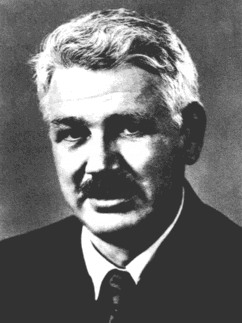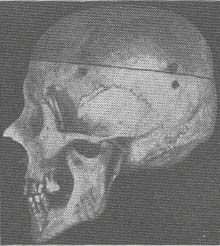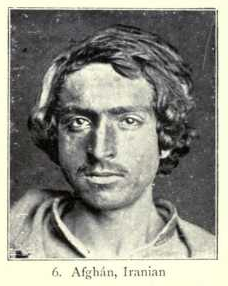Related Research Articles
The Aryan race is an obsolete historical race concept that emerged in the late-19th century to describe people who descend from the Proto-Indo-Europeans as a racial grouping. The terminology derives from the historical usage of Aryan, used by modern Indo-Iranians as an epithet of "noble". Anthropological, historical, and archaeological evidence does not support the validity of this concept.

Semitic people or Semites is an obsolete term for an ethnic, cultural or racial group associated with people of the Middle East, including Arabs, Jews, Akkadians, and Phoenicians. The terminology is now largely unused outside the grouping "Semitic languages" in linguistics. First used in the 1770s by members of the Göttingen School of History, this biblical terminology for race was derived from Shem, one of the three sons of Noah in the Book of Genesis, together with the parallel terms Hamites and Japhetites.

Carleton Stevens Coon was an American anthropologist. A professor of anthropology at the University of Pennsylvania, lecturer and professor at Harvard University, he was president of the American Association of Physical Anthropologists. Coon's theories on race were widely disputed in his lifetime and are considered pseudoscientific in modern anthropology.

The Dinaric race, also known as the Adriatic race, were terms used by certain physical anthropologists in the early to mid-20th century to describe the perceived predominant phenotype of the contemporary ethnic groups of southeast Europe.
Australo-Melanesians is an outdated historical grouping of various people indigenous to Melanesia and Australia. Controversially, some groups found in parts of Southeast Asia and South Asia were also sometimes included.
The concept of race as a categorization of anatomically modern humans has an extensive history in Europe and the Americas. The contemporary word race itself is modern; historically it was used in the sense of "nation, ethnic group" during the 16th to 19th centuries. Race acquired its modern meaning in the field of physical anthropology through scientific racism starting in the 19th century. With the rise of modern genetics, the concept of distinct human races in a biological sense has become obsolete. In 2019, the American Association of Biological Anthropologists stated: "The belief in 'races' as natural aspects of human biology, and the structures of inequality (racism) that emerge from such beliefs, are among the most damaging elements in the human experience both today and in the past."
The Caucasian race is an obsolete racial classification of humans based on a now-disproven theory of biological race. The Caucasian race was historically regarded as a biological taxon which, depending on which of the historical race classifications was being used, usually included ancient and modern populations from all or parts of Europe, Western Asia, Central Asia, South Asia, North Africa, and the Horn of Africa.
The Nordic race was a racial concept which originated in 19th-century anthropology. It was considered a race or one of the putative sub-races into which some late-19th to mid-20th century anthropologists divided the Caucasian race, claiming that its ancestral homelands were Northwestern and Northern Europe, particularly to populations such as Anglo-Saxons, Germanic peoples, Balts, Baltic Finns, Northern French, and certain Celts and Slavs. The supposed physical traits of the Nordics included light eyes, light skin, tall stature, and dolichocephalic skull; their psychological traits were deemed to be truthfulness, equitability, a competitive spirit, naivete, reservedness, and individualism. In the early 20th century, the belief that the Nordic race constituted the superior branch of the Caucasian race gave rise to the ideology of Nordicism.
The Mediterranean race is an obsolete racial classification of humans based on a now-disproven theory of biological race. According to writers of the late 19th to mid-20th centuries it was a sub-race of the Caucasian race. According to various definitions, it was said to be prevalent in the Mediterranean Basin and areas near the Mediterranean, especially in Southern Europe, North Africa, most of West Asia, the Middle East or Near East; western Central Asia, parts of South Asia, and parts of the Horn of Africa. To a lesser extent, certain populations of people in Ireland, western parts of Great Britain, and Southern Germany, despite living far from the Mediterranean, were thought to have some minority Mediterranean elements in their population, such as Bavaria, Wales, and Cornwall.
Nordicism is an ideology which views the historical race concept of the "Nordic race" as an endangered and superior racial group. Some notable and seminal Nordicist works include Madison Grant's book The Passing of the Great Race (1916); Arthur de Gobineau's An Essay on the Inequality of the Human Races (1853); the various writings of Lothrop Stoddard; Houston Stewart Chamberlain's The Foundations of the Nineteenth Century (1899); and, to a lesser extent, William Z. Ripley’s The Races of Europe (1899). The ideology became popular in the late-19th and 20th centuries in Germanic-speaking Europe, Northwestern Europe, Central Europe, and Northern Europe, as well as in North America and Australia.

The Alpine race is a historical race concept defined by some late 19th-century and early 20th-century anthropologists as one of the sub-races of the Caucasian race. The origin of the Alpine race was variously identified. Ripley argued that it migrated from Central Asia during the Neolithic revolution, splitting the Nordic and Mediterranean populations. It was also identified as descending from the Celts residing in Central Europe in Neolithic times. The Alpine race is supposedly distinguished by its moderate stature, neotenous features, and cranial measurements, such as high cephalic index.
The Armenoid race is a sub-race in the context of the Caucasoid race.
United States v. Bhagat Singh Thind, 261 U.S. 204 (1923), was a case in which the Supreme Court of the United States decided that Bhagat Singh Thind, an Indian Sikh man who identified himself as an Aryan, was ineligible for naturalized citizenship in the United States. In 1919, Thind filed a petition for naturalization under the Naturalization Act of 1906 which allowed only "free white persons" and "aliens of African nativity and persons of African descent" to become United States citizens by naturalization.
Various attempts have been made, under the British Raj and since, to classify the population of India according to a racial typology. After independence, in pursuance of the government's policy to discourage distinctions between communities based on race, the 1951 Census of India did away with racial classifications. Today, the national Census of independent India does not recognise any racial groups in India.

The Irano-Afghan race or Iranid race is an obsolete racial classification of human beings based on a now-disproven theory of biological race. Some anthopologists of the 20th century classified the populations native to the Iranian plateau as belonging to this race, which was usually seen as a subrace of the Caucasian race or the Mediterranean racial subtype of that race, depending on the authority consulted.
Mongoloid is an obsolete racial grouping of various peoples indigenous to large parts of Asia, the Americas, and some regions in Europe and Oceania. The term is derived from a now-disproven theory of biological race. In the past, other terms such as "Mongolian race", "yellow", "Asiatic" and "Oriental" have been used as synonyms.

The Turanid race was a supposed sub-race of the Caucasian race in the context of a now-outdated model of dividing humanity into different races which was developed originally by Europeans in support of colonialism. The Turanid type was traditionally held to be most common among the populations native to Central Asia. The name is taken from the phylum of Turanian languages, which are the combination of the Uralic and Altaic families, hence also referred to as the term Ural–Altaic race.
Thomas Callan Hodson (1871–1953) was the first William Wyse Professor of Social Anthropology at the University of Cambridge, where he was a Fellow of St Catharine's College, notable for his writings on Indian anthropology and for coining the term sociolinguistics.

Aryan or Arya is a term originally used as an ethnocultural self-designation by Indo-Iranians in ancient times, in contrast to the nearby outsiders known as 'non-Aryan'. In Ancient India, the term ā́rya was used by the Indo-Aryan speakers of the Vedic period as an endonym (self-designation) and in reference to a region known as Āryāvarta, where the Indo-Aryan culture emerged. In the Avesta scriptures, ancient Iranian peoples similarly used the term airya to designate themselves as an ethnic group, and in reference to their mythical homeland, Airyanǝm Vaēǰō. The stem also forms the etymological source of place names such as Alania and Iran.
Negroid is an obsolete racial grouping of various people indigenous to Africa south of the area which stretched from the southern Sahara desert in the west to the African Great Lakes in the southeast, but also to isolated parts of South and Southeast Asia (Negritos). The term is derived from now-disproven conceptions of race as a biological category.
References
- ↑ For the model of dividing humanity into races, see American Association of Physical Anthropologists (27 March 2019). "AAPA Statement on Race and Racism". American Association of Physical Anthropologists. Retrieved 19 June 2020.
Instead, the Western concept of race must be understood as a classification system that emerged from, and in support of, European colonialism, oppression, and discrimination.
- ↑ McMahon, Richard (2019). National Races: Transnational Power Struggles in the Sciences and Politics of Human Diversity, 1840-1945. University of Nebraska Press. p. 315. ISBN 978-1-4962-0582-7.
- ↑ Carleton S. Coon (1939). The Races of Europe. Dalcassian Publishing Company. p. 287.
- ↑ Coon, Carleton Stevens; Hunt, Edward E. (1966). The Living Races of Man. Cape. p. 207.
- 1 2 Proceedings and Transactions of the All-India Oriental Conference, Volume 10. All-India Oriental Conference. 1941. p. 485.
- ↑ Årsberättelse - Kungl. Humanistiska Vetenskapssamfundet i Lund: Bulletin de la Société Royale Des Lettres de Lund. CWK Gleerup. 1946. p. 47.
- 1 2 To Permit All People from India Residing in the United States to be Naturalized: Hearing Before a Subcommittee of the Committee on Immigration, United States Senate, Seventy-ninth Congress, First Session, on S. 236. April 26, 1945. United States Senate Committee on Immigration. 26 April 1945. pp. 5–6.
- ↑ Malhotra, K.C.; Vasulu, T.C. (2019). "Development of typological classification and its relationship to microdifferentiation in ethnic India". Journal of Biosciences . 44 (64): 64. doi:10.1007/s12038-019-9880-8. PMID 31389353. S2CID 195811912.
- ↑ Sharma, Ram Nath; Sharma, Rajendra K. (1997). Anthropology. Atlantic Publishers. p. 122. ISBN 978-81-7156-673-0.
- ↑ Wolf, Josef (1971). Integral Anthropology: An Introduction to the Study of Man, Culture and Society. Statni Pedagogicke Nakladatelstvi. p. 200.
The gypsies, who are actually of Indian origin and come from the North-West India region, are also akin to this Indid type.
- 1 2 Veer, Peter van der (14 January 2014). Conversion to Modernities. Routledge. p. 130. ISBN 978-1-136-66183-9.
Caldwell's articulation of the racial and historical basis of the Aryan-Dravidian divide was, in fact, perhaps the first European valorization of the Dravidian category cast specifically in racial terms, though he admitted the likelihood of considerable racial intermixture. At the same time, Caldwell was merely modifying conventional wisdom in his uncritical acceptance of an Aryan theory of race, in which Dravidians were seen as pre-Aryan inhabitants of India. The Aryan theory of race, based as it was on William Jones's well-known "discovery" of the Indo-Aryan family of languages, had been developed by German comparative philologists in the 1840s and 1850s. It maintained that the speakers of Indo-European languages in India, Persia, and Europe were of the same culture and race.
- ↑ Kuiper, Kathleen (15 August 2010). The Culture of India. Rosen Publishing. p. 71. ISBN 978-1-61530-149-2.
Dravidian languages are spoken by about one-fourth of all Indians, overwhelmingly in southern India. Dravidian speakers among tribal people (e.g., Gonds) in central India, in eastern Bihar, and in the Brahui-speaking region of the distant Pakistani province of Balochistan suggest a much wider distribution in ancient times.
- ↑ Playne, Somerset; Wright, Arnold (1915). Southern India, Its History, People, Commerce, and Industrial Resources. Foreign and Colonial Compiling and Publishing Company. p. 69.